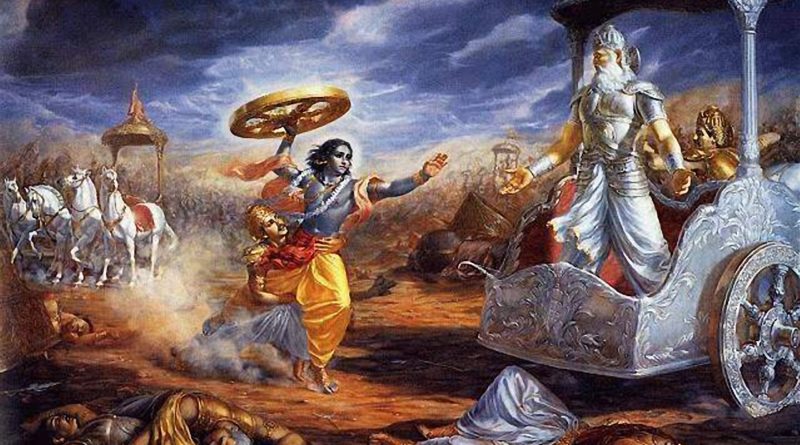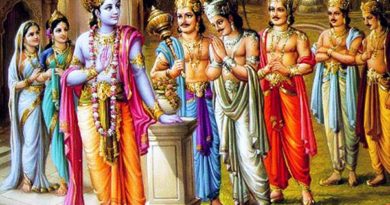Revisiting the Ancient Indian Laws of Warfare and Humanitarian Laws
The rules laid down in the Rig Veda maintain that it is unjust to strike someone from behind, cowardly to poison the tip of the arrow, and heinous to attack the sick or old, children, and women. This can be related with the Geneva Convention Relative to the Protection of Civilian Persons in Time of War of August 12, 1949, Part II dealing with the General Protection of Populations against Certain Consequences of War and specifically, Article 24 regarding measures relating to child welfare.
In the Ramayana, a classic example of the observance of humanitarian principles can be found when Lakshmana, in the war against Ravana, was forbidden by Rama to use a weapon of war which had the potential to destroy the entire race of enemy including those who did not bear arms, though Ravana was fighting an unjust war, Adharmayuddha. Another example can befound in the Mahabharata when Arjuna, observing the laws of war, refrained from using an ultra-destructive weapon Pasupathastra in a conventional war, for when fighting was restricted to ordinary conventional weapons, the use of extraordinary or unconventional types was immoral, besides contravening religious tenets or the recognized laws of warfare.[9] This is very much akin to the Geneva Convention Relative to the Treatment of Prisoners of War of August 12, 1949, Part III, Section II,Chapter VI dealing with Discipline and specifically, Article 42 regarding the use of weapons.
It is true that the Rig Veda refers to Dasas (slaves) and the epics Ramayana and Mahabharata refer to enslavement of war prisoners but it is also equally true that Smriti (remembered texts that are a codified component of Hindu customary law,different from Shruti which encapsulate Dharma through listening or hearing), condemn slavery and the Agni Purana clearly forbids the enslavement of prisoners which again is similar to the Geneva Convention Relative to the Treatment of Prisoners of War of August 12, 1949, Part II dealing with the General Protection of Prisoners of War and specifically, Article 14 regarding respect for the person of prisoners.
Also, some of the humanitarian aspects of the warfare rules put forth in the Shanti Parva of the Mahabharata have a striking similarity with the laws in the present international system notably, Chapter II dealing with the Quarters, Food and Clothing of Prisoners of War and specifically, Article 26 regarding food; Chapter III dealing with the Hygiene and Medical Attention and specifically, Article 30 regarding medical attention; and Article 31 regarding medical inspections. The prisoners of war were generally to be accorded generous treatment. In the epoch of the Brahmanas, the fettered prisoner was sent out of the king domand was permitted to remain on the outskirts. Sometimes the captive agreed to become a slave of the captor for a period of one year after which he became a free man. According to the Mudraaraakshasa, Kautilya set free the prisoners who were captured in war by the king Chandragupta.
It was the policy of the ancient Hindus that once in the field of action, the enemy could be subjected to rigor. But after the cessation of hostilities, the victor should behave in such a way as to secure the advancement of all, including the subjects of the enemy’s kingdom.[10] The Arthashastra also has a policy which states that the subjects of the vanquished monarch were allowed to retain their own laws and customs, as any violation of these would result in a mass rebellion. In a way, the laws of war in ancient India with regard to occupied territory were more humane and broader than those of today.
As far as envoys were concerned, a discussion between Ravana and his brother Vibhishana in the Ramayana elucidates the inviolability of an ambassador. Ravana planned to kill ambassador Hanuman, who appeared at his court on behalf of Rama. His brother Vibhishana reminded him that if he did kill the ambassador, he would be acting against Rajadharma (the duty of kings).[11] This can be traced as a root to the present day conventions and practices with regard to the sanguine principles and privileges of an ambassador especially, with respect to the Vienna convention on Diplomatic Relations 1961 regulating diplomatic immunities and privileges. Though a diplomat’s vision was only of a short duration in the ancient period and would end on completion of the agenda, it still holds relevance to the present day practices.
The ancient Indian literature has the potential for extraordinary development albeit at times, being considered as mythologicalby the Western scholars. As far as the international humanitarian laws are concerned, The Hague Conventions of 1899 and1907, Geneva Conventions of August 12, 1949 and the Vienna Convention on Diplomatic Relations, 1961 can be traced to the laws given in Manusmriti, epic codes and the war rules of Mahabharata, and the codes on diplomatic relations in Ramayana,respectively.
Sanathana Dharma recognizes the concept of humanitarian law in an indirect manner but with clarity. It restricts the means and the methods of warfare without causing harm to civilians or the protected persons. It indicates towards the forever demand of such regulation for the control of the armed race. The best example is the concept of Dharmayuddha which gives a humanitarian touch to warfare. It equally and sufficiently clears that, in terms of the ideals of humanitarianism of ancient India,the laws of war were more progressive.
In compliance with the Vedic literature, the crux regarding war is that it cannot be eradicated but ennobled. And this can be done only if men of good will foregather, if men forget the pride of race and birth which history, unfortunately, tries indirectly to preach,if men apply their minds honestly to the task of regeneration of mankind and if humanity adheres to the fundamentals of allreligions and strives to foster the spirit of brotherhood.
1.Agni Purana
2.Kautilya, Arthashastra
3.Manu, Manusmriti
4.Rig Veda
5.Sukra, Sukraniti
6.Vyasa, Mahabharata
7.The Geneva Conventions of August 12, 1949, International Committee of the Red Cross publicationEndnotes:[1] Gaurav Arora, Gunveer Kaur, Supritha Prodaturi, Vinayak Gupta, “International Humanitarian Law and Concept ofHinduism“, Zenith, International Journal of Multidisciplinary Research, Vol. 2 Issue 2, Feb. 2012, ISSN 22315780, p.2[2]. Francois Bugnion, “Customary International Humanitarian Law”, ISIL Yearbook of International Humanitarian and RefugeeLaw Vo. 7, p. 1[3] Kautilya, “Arthashastra”, Book VII, Ch. XVI[4] Gustav Salomon Oppert, “On the Weapons, Army Organisation, and Political Maxims of the Ancient Hindus: With SpecialReference to Gunpowder and Firearms”, Cornell University Library, 2009 p. 139[5] Ibid p. 114[6] Sir Henry Miers Elliot, “The History of India: As Told by Its Own Historians. The Muhammadan Period”, Volume 1 edited byJohn Dowson, Trübner and Company Publishers, 1867 p. 433 [7] Nagendra Singh, “India and International Law”, S. Chand & Co., New Delhi, p. 4
[8] V.R. Ramachandra Dikshitar, “War in ancient India”, Motilal Banarsidass Publications, New Delhi, 1987 p. 72
[9] Penna, op. cit., p. 191-192
[10] Vyasa, “Mahabharata”, Shanti Parva, 96.12-13
[11] Manoj Kumar Sinha, “Hinduism and International Humanitarian Law”, International Review of the Red Cross, Volume 87,No. 858, June 2005, p.292
Article is written by Radhika RV, who holds a Post Graduate degree in International Studies from Stella Maris College, Chennai. She can be reached at her LinkedIn and Twitter and is originally published in www.indrastra.com (http://www.indrastra.com/2017/03/Revisiting-Ancient-Indian-Laws-of-Warfare-Humanitarian-Laws-003-03-2017-0060.html) is reproduced with due acknowledgement of their and authors copy rights.




